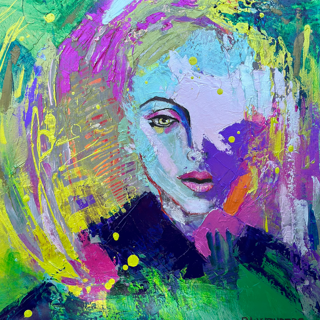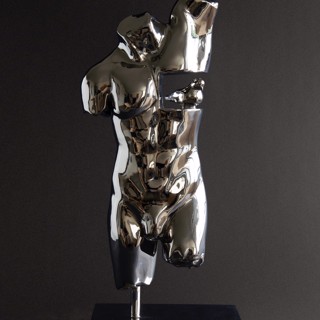Ricardo Lowenberg is a celebrated Mexican artist, called to the artistic process by an innate drive to express the emotions and essence of the human condition. Leaping between mediums, Lowenberg paints both abstract and figurative works, and sculpts voluminous forms that explore the trajectory of emotions beginning with their interiority and culminating with their visual expression. Guided by the phantasms of the Mexican Muralists and the French Impressionists, Lowenberg creates allegories and stunning portraiture, resplendent with the ecstasies of both the human and natural world and bursting with color and energy. Lowenberg’s decades-long search for perfection in painting has resulted in magnificent proficiency in different mediums, and numerous collections of undeniably beautiful and evocative paintings exhibited in some of the world’s finest galleries and private collections.
Born in Mexico City in 1960, The Artist was exposed to classical music and the creative experience from birth, and his innate sense of beauty and aesthetics was nurtured immediately. He began sculpting classes from the age of five and art school at a hacienda that also housed an adjoining orphanage, an experience that left an indelible mark on the artist’s psyche. His early works are clearly the result of a magnetic connection to the Impressionists. Having studied them from a young age he metabolized the visible brush strokes and sweeping vistas of Cezanne, Monet, and Gaugin as they played with the indefinable qualities of the passage of time.
In the early years of Lowenberg’s painting, the stylistic influence of Impressionism and Post-Impressionism resulted in such expressive works as “Les Jardins et Giverne” and “Homenaje al Impresionismo Frances Degas Les Ballerines” and propelled him to explore the mystery and emotion of abstraction. He exhibits an uncanny ability to depict the transformative quality of light and color to play with spatial and temporal order, as well as the energetic encounter with emotion that often eludes many painters. Just as Cezanne used small, impressionistic brushstrokes to capture the frenetic movement that is so critical to human perception, Ricardo Lowenberg deftly uses dynamic brushstrokes and unique visual planes to translate the humanity he explores to his canvas.
As he mastered the channeling of his artistic impulses into works of vivid colorscapes and euphoric organic modulations, he increasingly craved the revealing forms of figurative painting. Just as Gaugin bridged the worlds between Impressionism and Post-Impressionism, exploring the Symbolist movement, Lowenberg was called to a similar stylistic evolution. Renowned works such as “Michelle” (Oil on Wood) and “Adela” (Oil on Canvas) which expound a provocative interplay of emotion and the human form, allowed the Artist to explore the innate meaning of the human body to formally interrogate those ethereal and metaphysical properties that his previous abstraction built the foundation for. Using technical precision and skill honed from childhood, Lowenberg masterfully reproduced the human face before confronting it with the fracturing of color and angle, much like Picasso, best illustrated by his heralded “Mi Frida”, a seminal work from the series. Driven to the divine and ancient beauty of the female form, some of Lowenberg’s most arresting paintings are of female subjects. Of this celestial grace, Lowenberg states that he is ‘inspired by the possibilities of the feminine body, the abundant and generous curves, and the sensuality and innocence they represent.”
Lowenberg’s figurative painting period represents an artist searching for the elusive grasp on the question of what it means to be human. This search mirrors Lowenberg’s lifelong quest for perfection, an impulse that drove countless profound paintings, both abstract and figurative, but ultimately left Lowenberg seeking answers. Much like his influences, Lowenberg was compelled to different mediums in this search for perfection, like Gaugin to woodcuts and Picasso to ceramics. Finding that his conceptualization of perfection was unattainable and fundamentally meaningless, Lowenberg sought the “imperfectly perfect” instead, and in this quest, discovered The Magic Process.
The Magic Process began as a concept for a series of works but evolved into an idea far larger than its physical expression: a transcendental methodology that invited Lowenberg to re-encounter his craft as a painter and a sculptor. Originally conceived as a painting project, The Magic Process transformed into a series of twelve sculptures when Lowenberg became aware that he wanted the viewer’s gaze to impact directly on the form as it was perceived. As such, it was necessary to employ visual effects that could only be achieved through volume. From there, the process was born whereby sculpting became a means of personal expression that allowed him to react and defy the established parameters of perfection, becoming fully detached from space and time. Of sculpting, Lowenberg notes his full envelopment in the craft. “As I fully engage with my sculpture it becomes intimate, emotional, and above all, it allows me to highlight perfect imperfection.” Where painting for this Artist was a technical exploration of precision and technique, sculpting became a creative process that was entirely renewed. Its focus is on the emotional value of the method itself, as well as the expression of true interior emotion that resulted from the method and could be perceived by Lowenberg himself as well as viewers.
Works created within The Magic Process such as “Monica & Elisa” display an audacious encounter with the human form and the emotion it evokes. just as the Post-Impressionists rejected the limitations of Impressionism, Lowenberg’s style evolved to yet another level: to bypass the restrictions of the two-dimensional form to express the existential quality of the human condition. Of his figurative sculptures, Lowenberg states that “in the lump of clay I can see the form, I can see the potential, I can see the piece. It speaks to me even in the primordial form.” In “Oscar” as in “Regina” the painter’s technical prowess as a sculptor and precision as a translator of human physicality are unmistakable. His dedication to the marriage of organic form and anatomical meticulousness creates a vision of humanity and the perception of the emotion accessed through The Magic Process.
Lowenberg’s sculptural works employ lost-wax casting, and he uses materials of great strength and luminosity such as patinated or polished bronze and stainless steel. These materials, imbued with their innate quality to hold and reflect light, create striking effects of personality, and recall the material’s ancient and seemingly divine properties, particularly when manipulated by the Lowenberg. Polished stainless-steel acts like a silver mirror that reflects the fractals of surrounding life while simultaneously representing it in form, a duality that parallels the human condition Lowenberg seeks to express. Using the technique of lost-wax casting, Lowenberg can evoke the primordial human state using organic materials that belie the true humanity that is accessed when creating the works.
“I find that when I sculpt, I am fully present. This contrasts with my work as a painter, where I am constantly seeking to evolve and explore new techniques, to exceed what was previously achieved or renew my creative process from scratch.”
Ricardo Lowenberg has been exhibited both in his adored adopted city of Tampico, Mexico where his work was first exhibited in 1993, as well as countless global powerhouses of prestigious art and culture. The Artists’ 2007 Exhibition at the famed Hotel Hermitage Monte Carlo drew both accolades and global attention: positioning him squarely in the coterie of world-class Masters.
His Solo Exhibition in Mexico at the Centro Cultural Alfaro Siquerior Museum was inaugurated by one of the great Mexican Masters, José Luis Cuevas. The Museum Collection housed thirty-two pieces, all now part of influential private collections. Over his decades-spanning career, Lowenberg has taken his place as one of the greatest exponents of contemporary Mexican painting and sculpture.
The Artist’s works are in venerable Galleries in New York City, Houston, and Palm Beach, and renowned gallerists house his works and regularly exhibit his oeuvre. RL has participated in countless worldwide museum exhibitions in Miami, Berlin, New York City and Mexico.
Ricardo Lowenberg’s fundamental pursuit lies in the essence of the people and their surroundings. He searches for the ineffable quality of human existence and this search is actualized in the physicality of his work. His paintings and sculptures encompass a soul evident in the eyes of his characters and Lowenberg’s intention to display the spirit of living beings and items he paints has resulted in works that are core elements of the contemporary Mexican artistic movement.
The artwork communicates a mesmerizing joyfulness full of contrasts, mystifying cryptograms, color, and light while provoking the viewer to encounter the human form with a fresh and unique perspective. With The Magic Process guiding Ricardo Lowenberg, he creates masterful works that take their rightful and well-deserved place among the Modern Masters.




PRESS ARTICLES
PRESS INTERVIEWS
